For Indian art collectors, March 19, 2025, will be earmarked (most will agree) as the day MF Husain broke existing records at Christie’s auction sales, New York, by fetching an unprecedented price for his painting Untitled (Gram Yatra), dating back to 1954. That year, according to Krishen Khanna, who was present, a Ukrainian physician based in Delhi, working with the World Health Organization, had acquired the work for Rs 1,000.
Away from the heady exhilaration of art collectors celebrating this historic occasion, a small group of us found ourselves participating in a mission that was in its own way, most interesting, on the panel as members of the jury at Prem Jain Memorial Trust’s National Green Earth Challenge’s very first national competition for students. Our task was to judge the entries for projects of architecture, design and engineering by students who have made the journey to the capital as the finalists. Having won the earlier zonal competitions they had arrived in Delhi, in some instances, having travelled from distant towns and cities, for the final round, to present their projects before the jurors. In keeping with the theme, they were rethinking climate challenges pertaining to the imminent global warming and trying to offer sustainable options. As undergraduate students, their age group was between 18 to 22 years.
With this event, the Prem Jain Memorial Trust’s National Green Earth Challenge, a multifaceted education programme that holds visual culture at its core, was getting off the ground. It was an initiative spearheaded by Payal Jain, herself a reputed fashion designer and the founder member of the Trust, who had been working tirelessly on this programme over the past year, to honour the legacy of her late father, Dr Prem Jain, a visionary teacher, engineer and pioneer of the country’s Green Building movement.
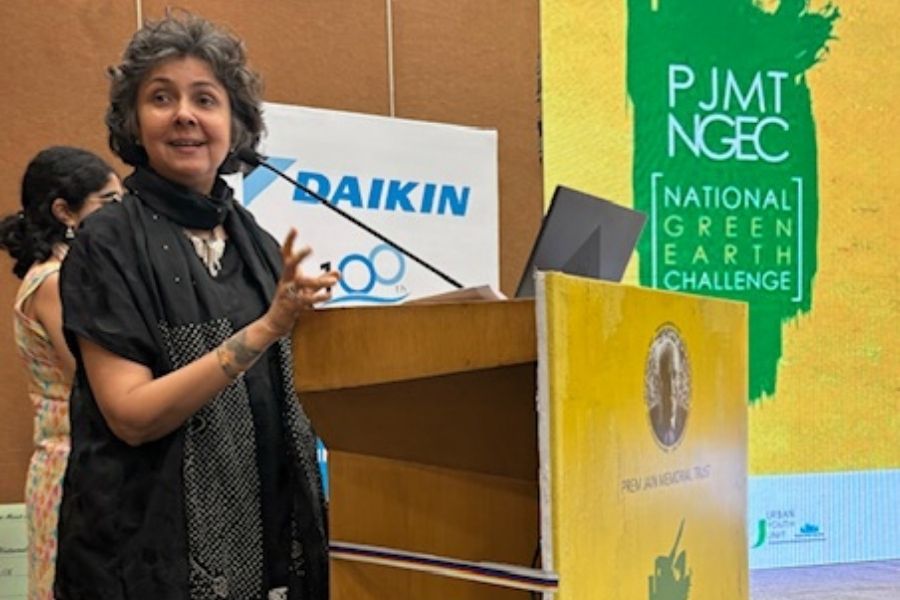
The initiative was spearheaded by Payal Jain
Our endeavour was to look for presentations that closely integrated the philosophy of ‘Panchabhoota’, or the five elements of ‘akasa’, ‘vayu’, ‘agni’, ‘jal’ and ‘prithvi’ that would result in the creation of a greener environment and a more sustainable future. The challenge had received 1,130 registrations from across India and it was now the jury’s duty to select the most deserving candidates amongst the 16 finalists. Our endeavour was to judge, not just the functionality and how sustainable it was, but also how it could benefit humanity in the long run. The group was exceptionally bright and it was interesting to hear them defend their products in the face of the formidable questions being posed, with each team quick to point out how they had adhered to the principles of the ‘panchabhoota’ philosophy, apart from creating something original and innovative.
As Hariharan Chandra (Founder Trustee of Alt Tech Foundation, INHAF) reiterated, “We need to especially recognise the products and concepts that could impact the markets of the future, centring around sustainability, economic efficiency and market appeal. That would decide be our criteria to select today’s winners.”
Each team had a unique product to present — from Ravali Arikala of G Narayanamma Institute of Technology & Science, who had experimented with algae, showing us how it could be integrated with fabric; to the NIFT student Onkar Ramesh More who almost convinced many of us that the organic bamboo toothbrush with tongue cleaner was the most essential and hygienic requirement in our toiletries. In teams or by themselves, the young men and women, already winners in their zonal competitions, were spirited and competitive, confident of making a mark for themselves.
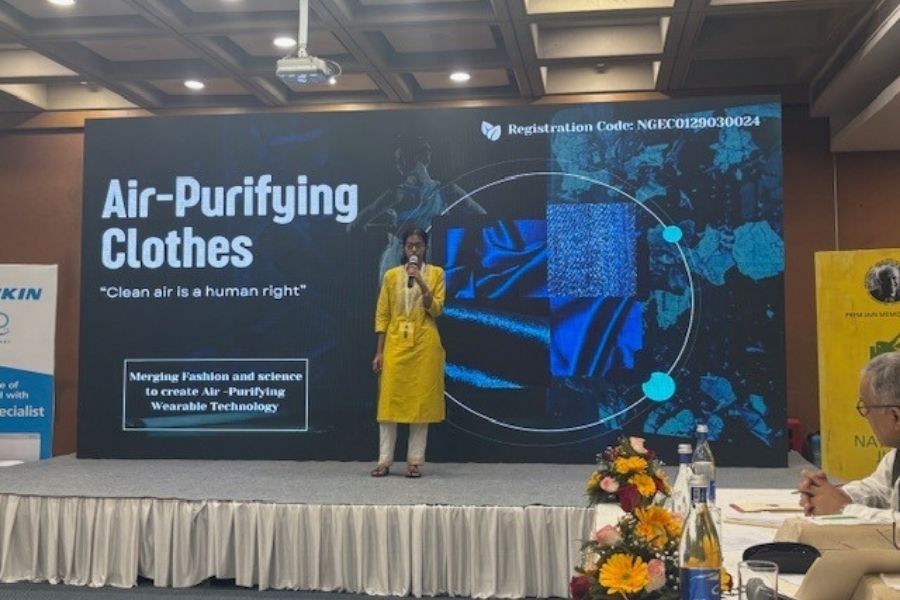
Ravali Arikala of G Narayanamma Institue of Technology & Science
A young woman, who had created an innovative product to clean sewage waters, especially grabbed my attention. More so because of a recent exhibition I had seen where Sudharak Olwe’s photographs had documented the plight of manual scavengers’ daily struggle to survive in the most severe conditions in Mumbai. Now, as I listened to the presentation, I found myself thinking that someday, possibly, with technological inventions and machines, maybe change could happen.
From the jury’s perspective, there were different yardsticks being considered. Sunil Sethi, president of the Fashion Design Council of India, asked Deeksha, the young lady from Patna NIFT, if the Sikki grass she had used for curtains and tableware were indeed cost effective and practical. Samat Chauhan, a fashion designer was already showcasing the Bhagalpur textiles in his recent fashion show in Moscow. Just sourcing local materials from Bihar was not enough, it had to be better than what already existed. Professor Satarupa Thakurta Roy (associate professor at IIT Kanpur, specialising in Fine arts, Design and Visual Communication) enquired of Deepanshu Pandey (IIT Delhi) about the durability of his organic shoe sole. Her query concerned the heel of a shoe he’d made using organic materials, how suited was it on Indian roads, she wondered, what if the pedestrian stepped on nails or broken glass.
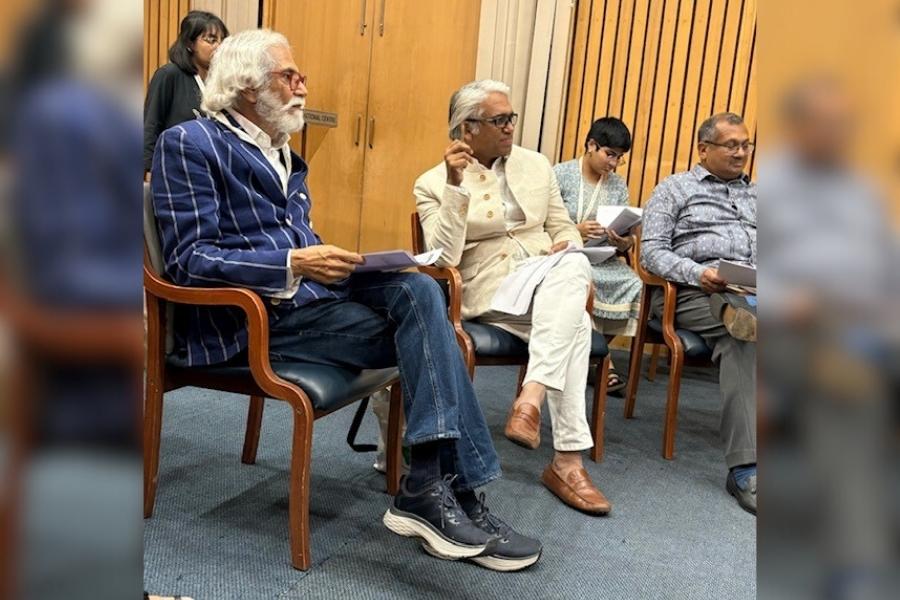
Jurors Sunil Sethi and Rajesh Pratap Singh
The technical expertise of V Suresh meant some tough questions for the contestants, after all, as chairman of CII- IGBC, he actively promoted the idea of green building, sustainable development and skill development in the construction industry in his own field, but when the questions were answered, he offered to mentor several contestants and that was what made the initiative so purposeful. The fact that the members of jury present were offering to guide the young people pursue their ideas further. Meanwhile, the artist in our midst was looking at the presentations from another equally important lens. Debasish Mukherjee said: “Art has a significant role to play in promoting sustainability. Artists have the power to communicate complex ideas in a subtle yet impactful way. The creative voices can inspire and educate, driving meaningful change.’
As we heatedly debated over the merits of each entrant, at the end of the day, the enthusiastic team headed by Aparajita Bharti from Young Leaders for Active Citizenship, partners of PJMT, came forward tallying numbers to help us resolve the decisions. Finally, a general consensus was arrived at and we had our winners selected in the different categories.
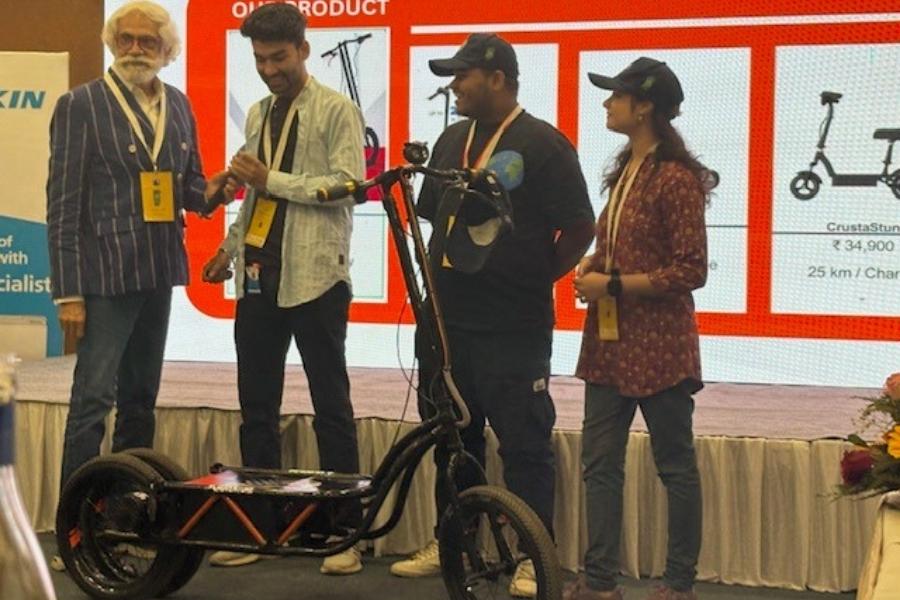
Mohd Sahil, Vishal Kumar and Yashika Wahi from Monad University, Hapur
While in the design category, Mohd Sahil, Vishal Kumar and Yashika Wahi from Monad University, Hapur, received the award for their ingenuously created smart scooter with built-in GPS, it was DY Patil Pune’s team of Prathamesh, Soham and Vishwajeet who were runners up for developing a sustainable carbon-footprint-and-smoke analyser for vehicles.
Shantanu Gadhia from Nirma University, Ahmedabad, fetched the first prize, whose model of a ‘nuclei village’ was designed specifically for remote, mountainous areas prone to earthquakes. Professor KT Ravindran, urban designer and former professor at SPA, Delhi, known for his own contribution to sustainable architecture and urban conservation, had tough questions to ask being an expert on the field. But in the end, all of us agreed that this was the most deserving entrant. Deservedly, Gadhia claimed the National Prize for his transdisciplinary approach, integrating environmental, social and technological aspects with an eye to suit the social, educational and cultural requirements of the community. The runner-up was Kareena Anna Jacob from Saintgits College of Engineering, Kottayam, who was working with Biopolymeric Hydrogels for sustainable water treatment.
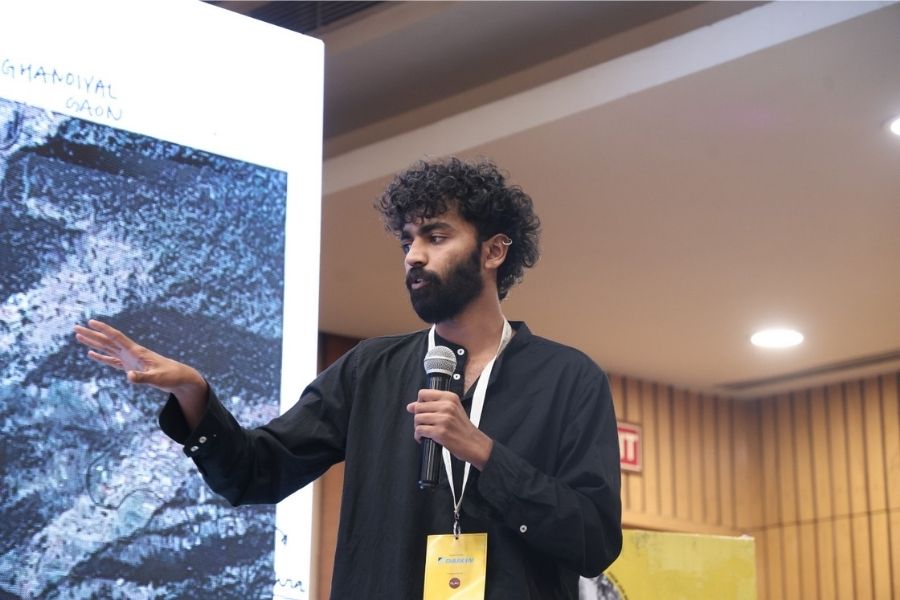
Shantanu Gadhia from Nirma University, Ahmedabad
As Rajesh Pratap Singh, fashion designer and juror put it, “What greater joy is there than to empower and nurture the next generation of visionaries, shaping not only their own futures, but also the world they will inherit?’ Fellow jury member, KT Ravindran, summed up our endeavour perfectly, saying, “An initiative like this must, in future, engage with more institutions and not merely the elitist sections and we must be there to support such ventures.’ After all, the onus to create sustainable and culturally responsive spaces is a collective responsibility.
Ina Puri is an arts writer, independent curator and collector.
